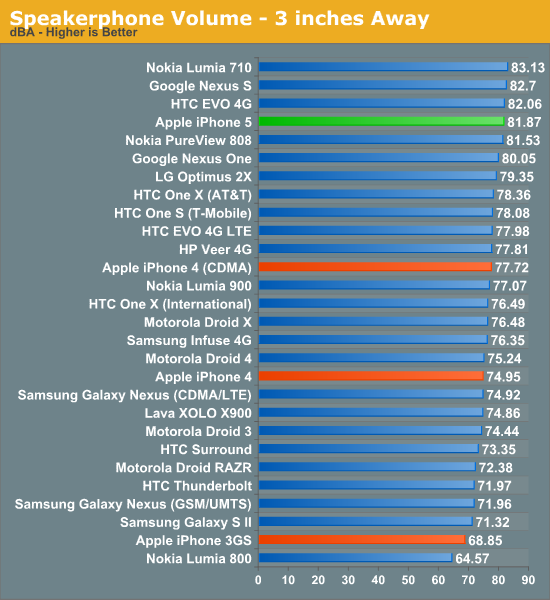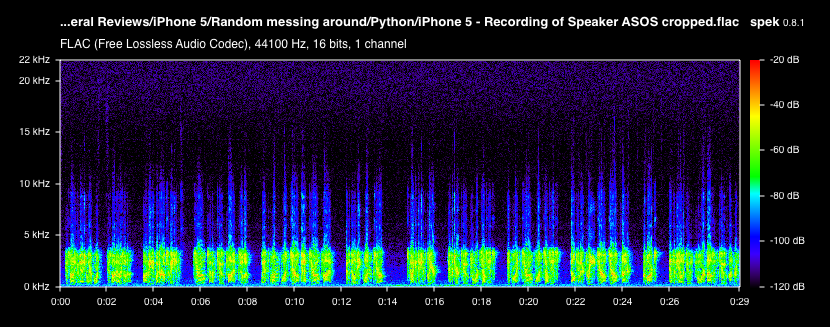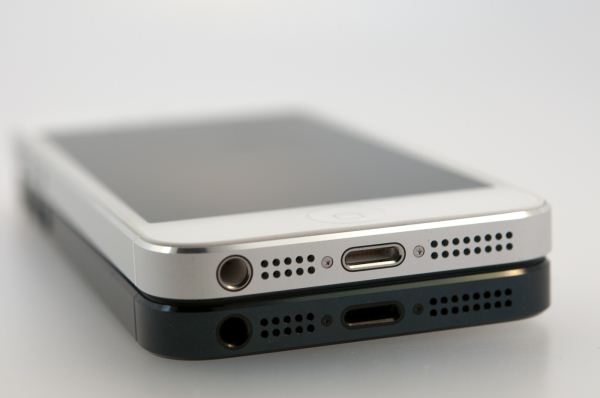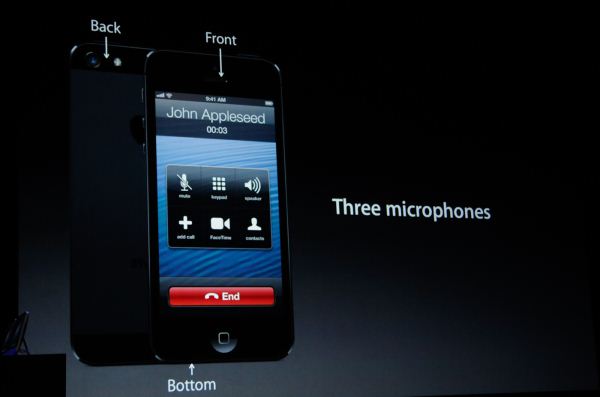The iPhone 5 Review
by Anand Lal Shimpi, Brian Klug & Vivek Gowri on October 16, 2012 11:33 AM EST- Posted in
- Smartphones
- Apple
- Mobile
- iPhone 5
Speakerphone and Noise Suppression
Section by Brian Klug
When Apple changed up the dock connector with the smaller Lightning port, it afforded a chance to also redesign the speakerphone at the bottom of the iPhone 5. Between the iPhone 4 and 4S we saw minimal changes, and performance was acceptable if a bit on the quiet side. With the iPhone 5 Apple advertised a big gain in audio quality with both changes to the speaker and a 5 magnet transducer design.
We normally test speakerphones by calling the local ASOS test number at max volume in front of an Extech sound data logger sampling continually and then averaging over one readout of the weather report. This gives a good feel for the overall loudness of the speakerphone on a call, but doesn’t tell us anything about quality unless you’re standing in front of it. In this case, the iPhone 5 is quite loud and comes in near the top of our scale at 81.8 dBA. It isn’t chart topping but a definite improvement over the relatively quiet 4/4S speakerphone design.

I decided to do something different though after getting a lot of questions and emails asking for a better quality comparison between the iPhone 5 speaker and its predecessor. People are interested in using their smartphones to listen to music when speakers or a dock aren’t available, and I thought this worth investigating. To get to the bottom of this I used my Blue Yeti USB microphone and arm which I use for podcasting to record the speakerphone output at 90 percent volume on the iPhone 4S and iPhone 5.
I started with the test call, which sounds surprisingly different between the iPhone 4S and iPhone 5. The 4S saturates and has obvious distortion even at 90 percent volume. This is quite noticeable in the recording. It then occurred to me that because I’m calling over AT&T (narrowband AMR) and to a PSTN (public switched telephone network) that the call would be limited to 4 kHz thanks to filters along the route, therefore anything above 4 kHz is undesirable. I took a spectral analysis (which shows power spectral density), and instantly it became obvious just how much energy there is on the 4S above the 4kHz limit from overmodulation or saturation/clipping on that speakerphone design. Meanwhile the iPhone 5 has much less energy over that 4 kHz maximum for a PSTN call.
I did the same for two songs recorded start to finish, and the differences are quite noticeable even in my rather quick and dirty recording plus spectogram comparison. I cropped the two recordings of the songs quite a bit and stuck them on soundcloud.

My overall impressions with the iPhone 5 speakerphone is that it has much less of a tendency to clip and saturate than the 4S, all while being noticeably louder. It’s still a smartphone speakerphone but to my ears the difference is pretty dramatic.
Noise Suppression
We’ve known for a while now that Apple changed up the slot for noise cancellation in the iPhone 5. The story goes something like this — Audience was a discrete chip on the iPhone 4, an IP block on the A5 SoC for iPhone 4S, and also an IP block onboard the A6 SoC for iPhone 5. The difference is that with iPhone 5 Audience isn’t enabled, and the company knows this because final characterization with both the final industrial design, microphones, and performance was never performed. Audience claims it met all of its deliverables and targets with the new IP block it built and gave Apple for inclusion on the A6. There’s obviously a lot of speculation about exactly why Apple chose to go with its own soultion versus Audience.
We’ve seen Audience earSmart noise suppression processors in a number of smartphones to date, and carriers often have their own specification for noise suppression to get certified. In addition, with wideband voice (AMR-WB in the case of the iPhone 5) noise suppression is even more important, to say nothing of how big of a topic this is with voice recognition based features like Siri. While we’re on the subject of AMR-WB, this feature is enabled on the iPhone 5 but I’m unable to test it on any of the carriers in the USA at the moment.
Anyhow, the iPhone 5 uses an Apple-specific solution with three total microphones all around the device. One primary microphone at the bottom of the device where you’d expect the primary microphone to reside, a secondary microphone between the LED flash and camera module, and a third right next to the earpiece for use with earpiece active noise cancelation. Apple’s solution is a beamformer (Apple said so in the keynote) and from what I can tell thus works entirely in the time domain. I’ve spent a lot of time playing around with the iPhone 5 trying to characterize its noise rejection, and the system appears to have a number of modes it will kick into after a 5–10 second adaptation time.
Earpiece noise rejection is something I talked about on the podcast right after the iPhone 5 hands on, and is one of those modes that the iPhone 5 will kick into if you’re in a loud environment. It isn’t active all the time, but when it does transition into working it provides a noticeable suppression of ambient noise and the same kind of pressure I’ve felt with other active noise canceling closed ear headphones. The improvement isn’t overwhelming, but it’s a sensation and feature I haven’t experienced on any other smartphones to date.
The rest of the noise suppression story is really one of testing. To test, I ran our normal test suite which consists of me ramping ambient music to 94 dBA while speaking into the device under test and recording the other side of the call. I’ve gotten ahold of the industry standard babble and distractor tracks used by carriers for testing noise suppression and will move to those in the future, for now though the test track I currently play is something I understand pretty well.
The comparison here is between the iPhone 4S and iPhone 5 to see just how ambient noise suppression has changed with this change in solution. The difference in technique is pretty apparent, and again indicates to me that the iPhone 5 is working in the time domain. You can see visible cut in and cut out on the waveform. The Audience solution has some hiss that develops at the absolute highest background noise volume on the 4S, but it also does an excellent job suppressing noise. The Apple solution doesn’t have this hiss, but passes both background noise and vocals from the music passed through the call at maximum volume. I hate to call this a regression, but the difference in technique means that there’s audible background noise that gets passed on while I’m talking on the iPhone 5. I think for normal callers the difference won’t be readily apparent, but with close inspection it is dramatic.













276 Comments
View All Comments
darwinosx - Tuesday, October 16, 2012 - link
The iPhone 5 display is better than any current Android display.But Motorola and Android if you want a company that is dying and being sold and a copycat cheap phone with no service and support.
V-Money - Tuesday, October 16, 2012 - link
Your wisdom and informative argument adds tremendous value to this post. For the record though, the OP said specifically battery life and 720p display, so the response was relevant.The rest of your post is petty, get over yourself. If you are going to play the copycat card you should have done it before Apple decided to go with a bigger screen and use a (eerily similar) notification bar to what Android phones have had for years.
As for quality (of display or otherwise), that is subjective analysis and considering that Apple only releases one phone at a time and Android manufacturers many, its a stupid argument for anyone to make. Case and point, I can find many android phones that are much more terrible than the iPhone, but I can also find many that are better. The iPhone is a decent phone, but its not for everyone. Every consumer has their preference.
My point being there is not one-size-fits-all phone, so quit acting high and mighty with your close mindedness. You are not better than those around you because you bought into Apple's marketing, you are just a fool dealing with the first world problem of living such a meaningless existence that you have to hold on to the imaginary power an inanimate object pretends to give to you.
Alucard291 - Tuesday, October 16, 2012 - link
I feel that your argument may be too good for him to reply to :)He seems awfully angry :D
crankerchick - Tuesday, October 16, 2012 - link
Great reply. If there's one place I just want to exchange comments without playing the "my toy is better than yours" game, it's here on AnandTech.Gradly - Wednesday, October 17, 2012 - link
I'm sick of ppl comparing iPhone to other devices. I'm sick of those telling you iPhone borrowed the notifications slider form android and skipping the myriad of things that other borrowed form iPhone. Apple has always said that "we are not the first but we do it the best". I'm sick of those who still don't realize that before iPhone ppl were living in caves actually.I'm an Apple lover not an Apple fanboy. I just adore the design, aesthetics, and GUI of Apple devices.
Penti - Wednesday, October 17, 2012 - link
It's sadly Apple that goes and patent UI-elements to use against their competitors that is why it's always brought up. It would be totally unnecessary otherwise. You might look at who's the inspiration otherwise and it's often not Apple. In reality we had capacitive touch screens (it's not Apples tech of course) before, app store before, Android even had an SDK out before Apple. Competitors like Symbian/Nokia, HP WebOS, and Blackberry are even allowed to use stuff like bounce back effect even without (or before) any agreement with Apple. They should have credit but they didn't all the sudden bring out their device with what we now call smartphone features, it lacked most functions at first and slowly iterated, it did a lot poorer in many areas then it's competitors was doing even before iPhone and the first few years it also showed in sales numbers which were not high at the first 2-3 years. It did show us how important a good platform was. Guys like Rubin had already figured that out though. So I'm not sure what they would borrow. Full WebKit-browsers on mobile is a good example of stuff they are co-developing but it was out in Nokia devices in 2006, netfront and Opera was never good alternatives to build into your platform. Stock Android don't have the bounce back effect, UI's looking like Apples and so on. Not even TouchWiz on Samsung's tablets looks like or infringes anything (design-wise) by Apple. They clearly have their own ideas. They are not the "me too", others might try to emulate them more in a business sense though. But they will be punished by the market by their execution instead of by Apple. It's not like any of the major players are fruit ninja-clones though.iPhone was desperately rudimentary at first. It didn't do applications and the web, messaging, photos etc better then anybody. What they did good was to iterate and improve. They take enterprise / corporate customers more seriously then Microsoft and so on in this field. Even if it took some time for them to get there. So they do plenty of good. It's a good platform, but it's not like they gave their competitors their blueprints for their devices / os of today back in 2007 and both have made many improvements. Well maybe not Microsoft but it takes a few years to start over. Apple has even got into hardware (components) a bit. Commoditization and convergence has reached far beyond the mobile field. That's great even if Apple won't enter them. Still don't know why any competitor would like to turn themselves into a retail giant and employ mostly store staff as Apple does – Microsoft should start doing what they are good at instead. Google would be the most evil company in the world if they had started to patent and sue based on UI-features and methods. Or if they really tried to stop Bing and Bing Maps (and getting it banned in some markets) for example. It doesn't really matter who was first and who invented what if you take it to court were that doesn't really count and that creates a lot of BS surrounding the whole issue and companies involved that is largely unnecessary. But the real silly thing is why they fight. It's not based on IPR, it's basically that they want to be alone in doing whatever, even if they can't really make that claim to have sole rights to something. But ultimately courts do get that under control even when corporate leaders turn to fighting outside of releasing product.
slickr - Tuesday, October 16, 2012 - link
LOL. Don't make me laugh. It has still the worst display and has had the worst display for at least 3 years.A5 - Tuesday, October 16, 2012 - link
Your response is just as dumb as his. The iPhones have excellent displays.medi01 - Wednesday, October 17, 2012 - link
None of the iPhones have anything to compare with AMOLEDs, on top of having idiotic resolution.On tablet space, only iPad 3 matched color gamut of THE FIRST Samsung Galaxy Tab.
thunng8 - Wednesday, October 17, 2012 - link
How does 67.5% of sRGB on the galaxy tab 10.1 match the 94.4% on the ipad 3?http://www.anandtech.com/show/5688/apple-ipad-2012...